- Read a book with Aboriginal pictures paying attention to beautiful pictures of art and their meaning
- A thought about the picture she would like to draw
- Prepared cards board with colour that suited the theme the best
- Cut out curvy lines to make the picture more interesting
- Used cotton tips to paint pictures with dots
- Gave it a name.
Australian Aboriginal Dot Painting for Children and Art Resources
Disclosure: This post may contain affiliate links at no cost to you. It means I get a commission if you decide to purchase through my links. Thank you for your support. Stock Images supplied by Canva.
Australian Aboriginal culture is one of the oldest and most fascinating cultures in the world. It has a rich history and deep spiritual beliefs that are still practiced today. The Aboriginal people believe that the land is sacred and that they have a special connection to the land. They have a strong sense of community and believe in the importance of family and storytelling.
Art and music are also an integral part of their culture, with many of their traditional stories and customs being passed down through these mediums. Despite the challenges they have faced throughout history, the Aboriginal people have managed to maintain their culture and traditions, and their resilience and strength continue to inspire people around the world.
Australian cultural heritage that is passed on for thousands of years by its Indigenous people is very authentic, deeply rooted, and represents all the beauty and tranquillity that nature so generously provides. I found that there is a lot for children to learn about Visual Art through the world of Aboriginal art.
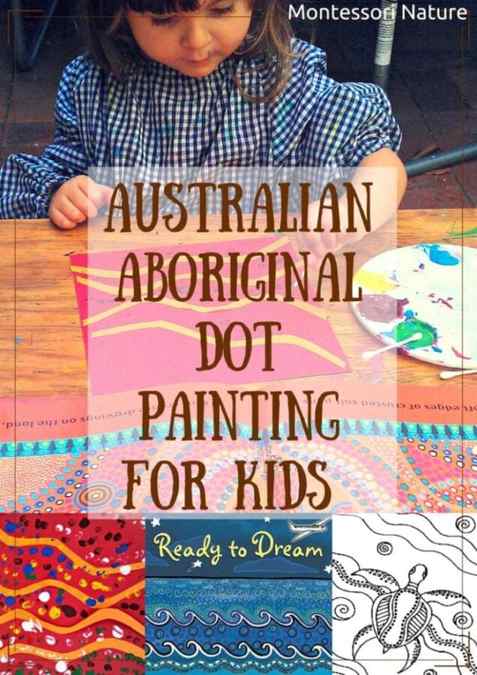
It does not just represent a form of self-expression. Indigenous art is also a response to the world that conveys meaning and has a spiritual purpose.
Even decorative designs found on objects such as shields, boomerangs, and baskets may represent symbols relating to the spiritual or dream world and illustrate relationships with nature.
Originally, the indigenous people of Australia used dots to disguise the sacred meanings behind the stories in the paintings. They drew designs that included dots on the soil, and sand, and made body paintings for ceremonies because they could easily erase them as they were considered sacred.
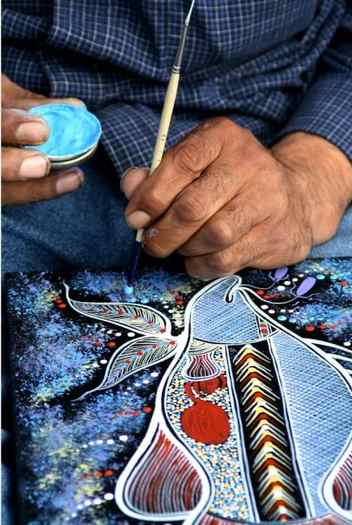
Dot painting originated in 1971 as a Papunya Tula Art Movement. To keep their messages hidden from others, Aboriginal artists removed the sacred elements and abstracted the designs into dots to hide their sacred meanings.

Now dot painting is one of the prevalent Aboriginal Visual Art techniques children enjoy doing so much. We were very excited to try it. Doing visual art with children is fantastic for their fine motor, especially this one. A used cotton tips for dipping into the paint and making patterns with dots.
Indigenous people use colors associated with the earth, including brown, amber, brick red, terracotta, yellow ochre, warm grey, burnt sienna, tan, and shades of green such as moss. We used colours that are very close to colours mentioned above.
Australian Aboriginal dot painting is a fun and creative activity that kids can enjoy. This type of art is inspired by the ancient traditions of the Aboriginal people of Australia. The key to creating a beautiful dot painting is to use vibrant colors and dots of different sizes to create intricate patterns and designs.
To get started, all you need is some paper, paint, and a set of paintbrushes or cotton swabs. Kids can use their imagination to come up with their own designs or look up traditional Aboriginal patterns for inspiration. Once they have their design in mind, they can start painting dots in different colors and sizes, layering them on top of each other to create texture and depth.
Not only is dot painting a great way to encourage creativity and self-expression, but it also provides an opportunity for kids to learn about the rich culture and history of the Aboriginal people. So why not give it a try and see what beautiful creations your kids can come up with?
Inspired by a gorgeous book with Aboriginal paintings “Why I Love Australia” my daughter did her dot painting.
Here is what we did:

- Read a book with Aboriginal pictures paying attention to beautiful pictures of art and their meaning
- A thought about the picture she would like to draw
- Prepared cards board with colour that suited the theme the best
- Cut out curvy lines to make the picture more interesting
- Used cotton tips to paint pictures with dots
- Gave it a name.
It was lots of fun and a great learning experience for my 3-year-old preschooler.

We often revisit activities that are inspired by Indigenous Art and culture with my children, especially when we talk about Australia and its cultural heritage. We have conversations about the land where we live in the context of its original custodians who lived in harmony with nature. We look at their way of living which was and is so intricately connected to nature, the landscape, the flora, and the fauna of Australia.
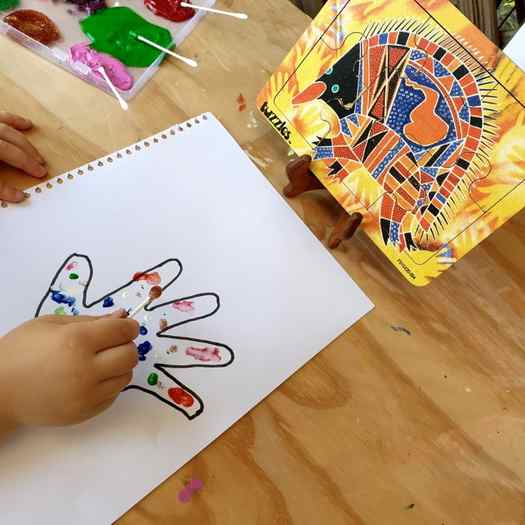
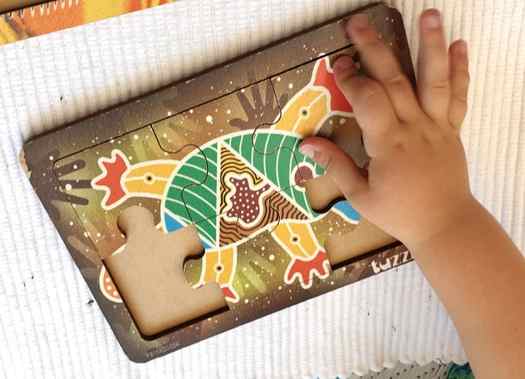
Exploring Native Australian culture brings a very strong realisation of just how far we disassociated our identity from the natural world.
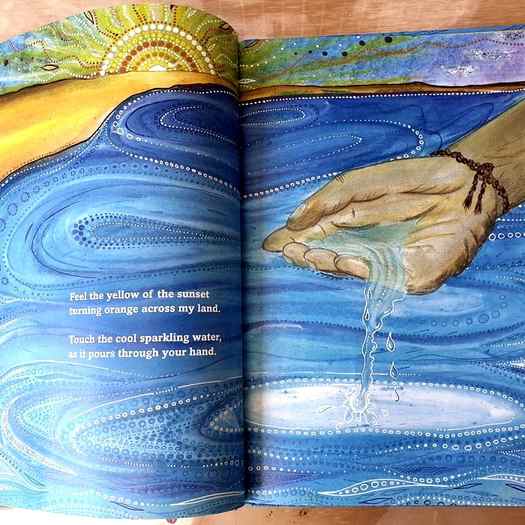
We treasure the moments when we can get a glimpse of the mystery of human nature that is rooted in centuries of staying connected to the land.
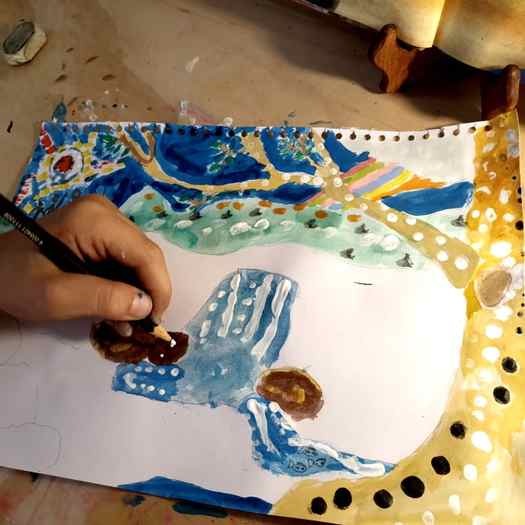
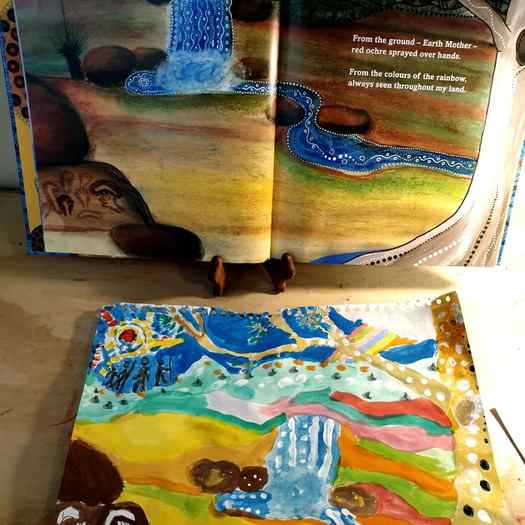
My children thoroughly enjoyed this book by Gregg Dreise My Culture and Me.
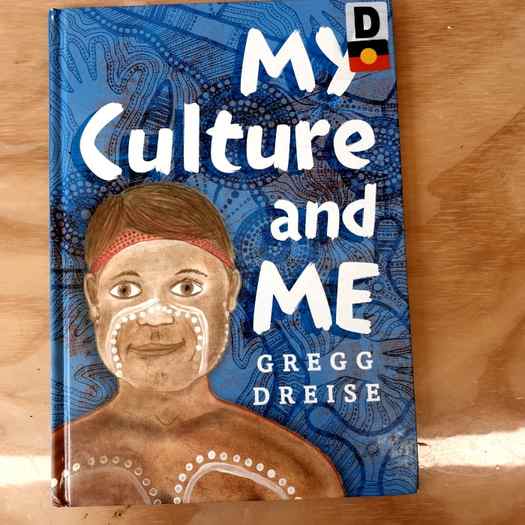
There are vast resources for teaching and encouraging the discovery of Indigenous Visual Art in Australia. This is an excellent lesson on teaching children to do dot-art
Read more about the techniques and colours of Aboriginal Art here.
Kid Books with Indigenous Art: “Why I Love Australia”
Australian Dot Art (4th)

To begin with I showed my students a PowerPoint to first show them where Australia is on a map, and then to give them a little background about Aboriginal Australian art – and more specifically their dot art style. We also watched this video clip.
We talked about how aboriginal Australian artwork contained a lot of symbolism and was often very stylized (like the images of animals). They also often used an ‘x-ray style’ when painting animals in their artwork.  I gave each of my tables a packet of animal silhouettes that I printed off from online (small enough that they couldn’t even try to trace) and asked them to select an animal that they’d like to draw. Students then tried their best at drawing the animal silhouette (with no additional details) on a piece of brightly colored construction paper that they selected. Once the drawing was completed, they cut out the silhouette and glued it onto a sheet of 9″ x 12″ black construction paper. Then the dot fun began! 🙂
I gave each of my tables a packet of animal silhouettes that I printed off from online (small enough that they couldn’t even try to trace) and asked them to select an animal that they’d like to draw. Students then tried their best at drawing the animal silhouette (with no additional details) on a piece of brightly colored construction paper that they selected. Once the drawing was completed, they cut out the silhouette and glued it onto a sheet of 9″ x 12″ black construction paper. Then the dot fun began! 🙂  Each table got a palette of different colored tempera paints and a bunch of wooden scratch sticks.
Each table got a palette of different colored tempera paints and a bunch of wooden scratch sticks.
Students dipped the scratch stick into the paint and then went to town dotting their papers (you can probably get a good 3 dots before you have to get more paint on the stick).
Some students really got into the project and committed themselves to working hard to finish it, while others got impatient with how long the dotting process was taking. I’d say it was a 60/40 split respectively.
I love this lesson though – and those students that understood that with commitment comes great reward.. were rewarded greatly with their beautiful results! 🙂





